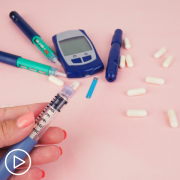Does GVHD Ever Resolve in Acute Myeloid Leukemia Patients?
Does GVHD Ever Resolve in Acute Myeloid Leukemia Patients? from Patient Empowerment Network on Vimeo.
With acute myeloid leukemia (AML) patients, graft-versus-host disease can manifest after bone marrow transplant. Watch as expert Dr. Catherine Lai explains how GVHD can vary by patient and what younger AML patients might expect for GVHD improvement over time.
See More from Best AML Care No Matter Where You Live
Related Resources:

What Role Does Telemedicine Play in Acute Myeloid Leukemia Care? |

|

What Treatments Are on the Horizon for Acute Myeloid Leukemia Patients? |
Transcript:
Sasha Tanori:
After getting a bone marrow transplant three years later, I’m still dealing with graft-versus-host disease or GVHD, but there are other obstacles that I’m also facing. Does GVHD ever truly go away or is it something that I’m going to have to learn to live with?
Dr. Catherine Lai:
Yeah, I wish I had a magic answer for you. Our data is that it gives us guidance for each patient, but then also each patient as an individual and how they respond to different medications, and the nuances of that is…it can be different. So what I would say is that there are patients who you have chronic GVHD for years, and it can eventually go away. And in some patients, they deal with it for a lifetime, you’re young enough, and I’m hopeful enough that at some point it will improve and get better. So I would be cautiously optimistic that things will improve.






